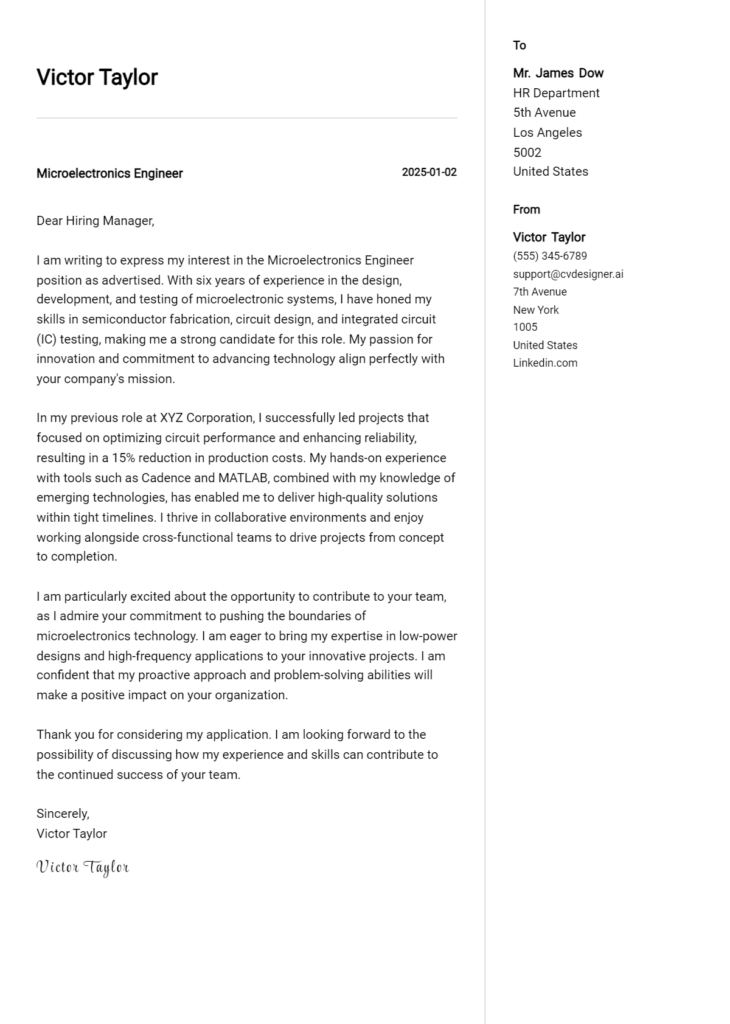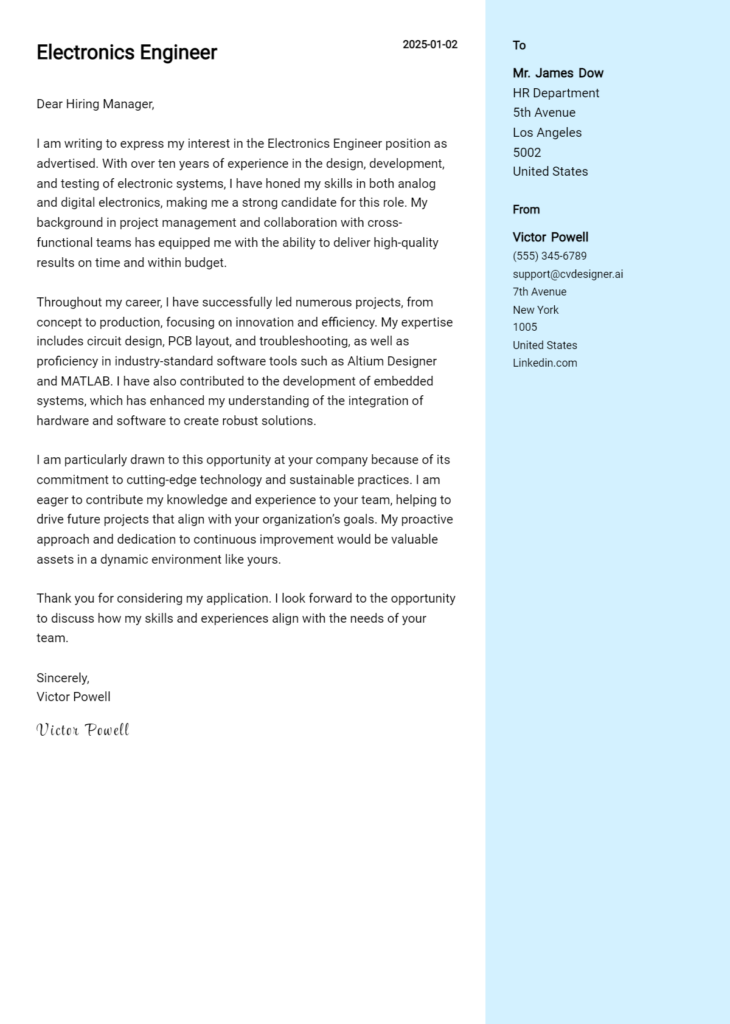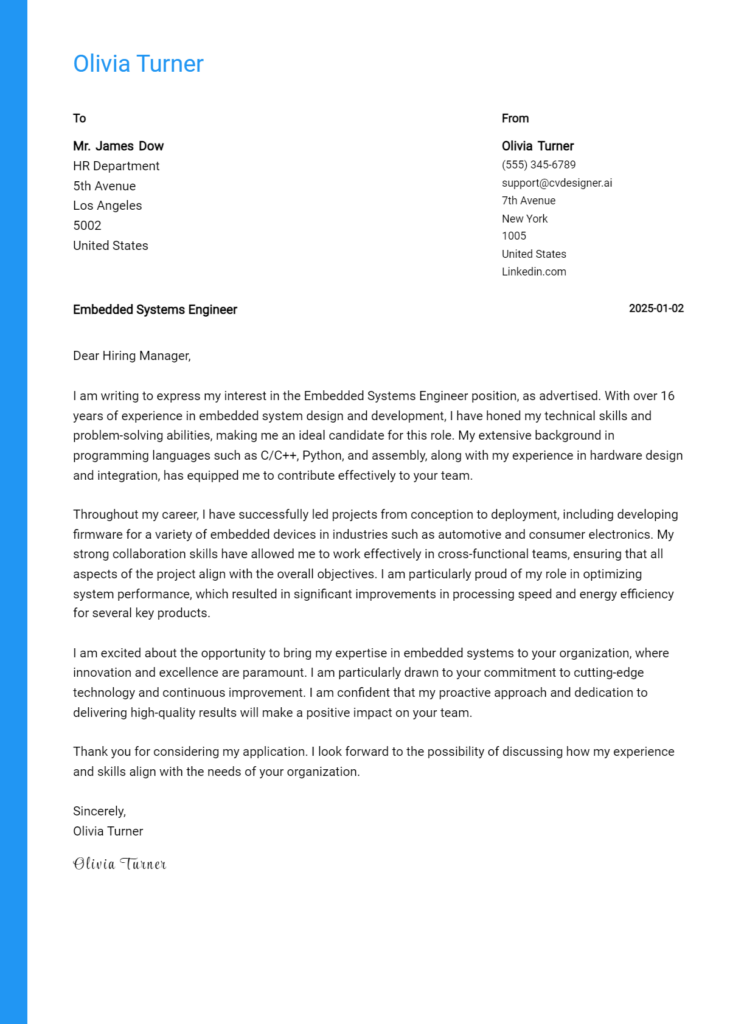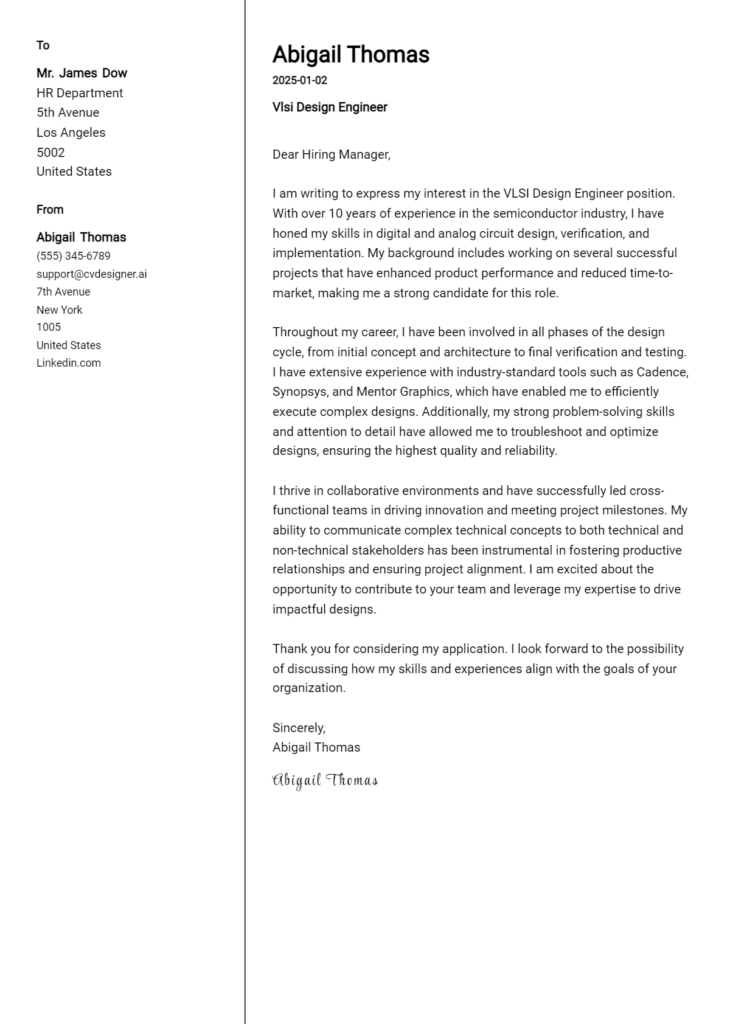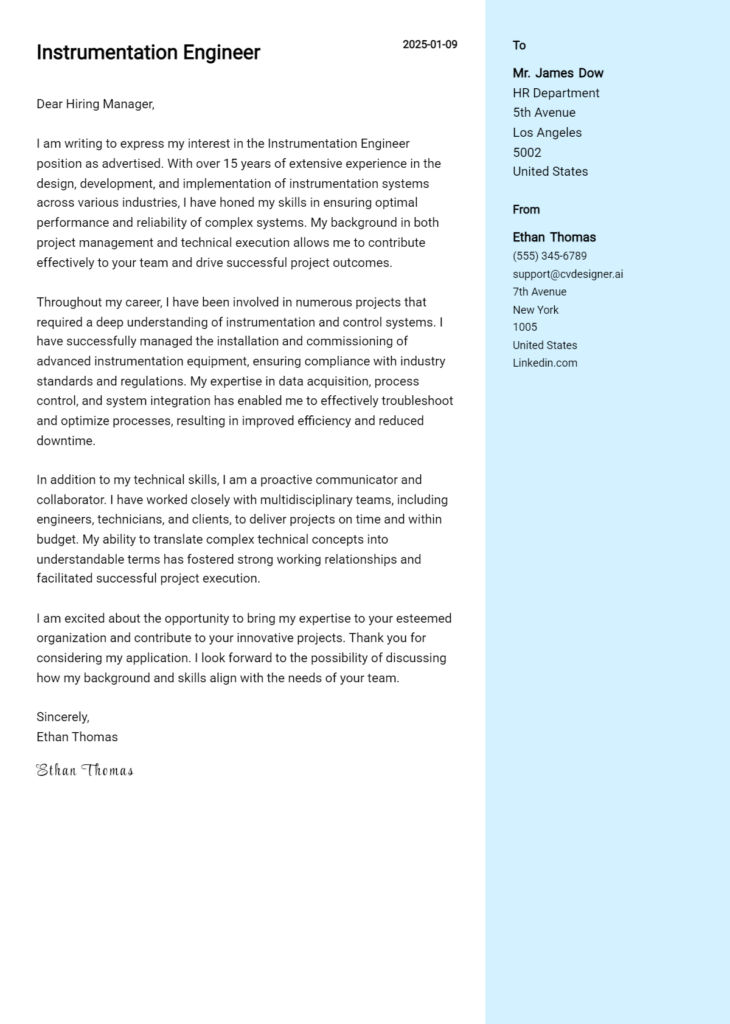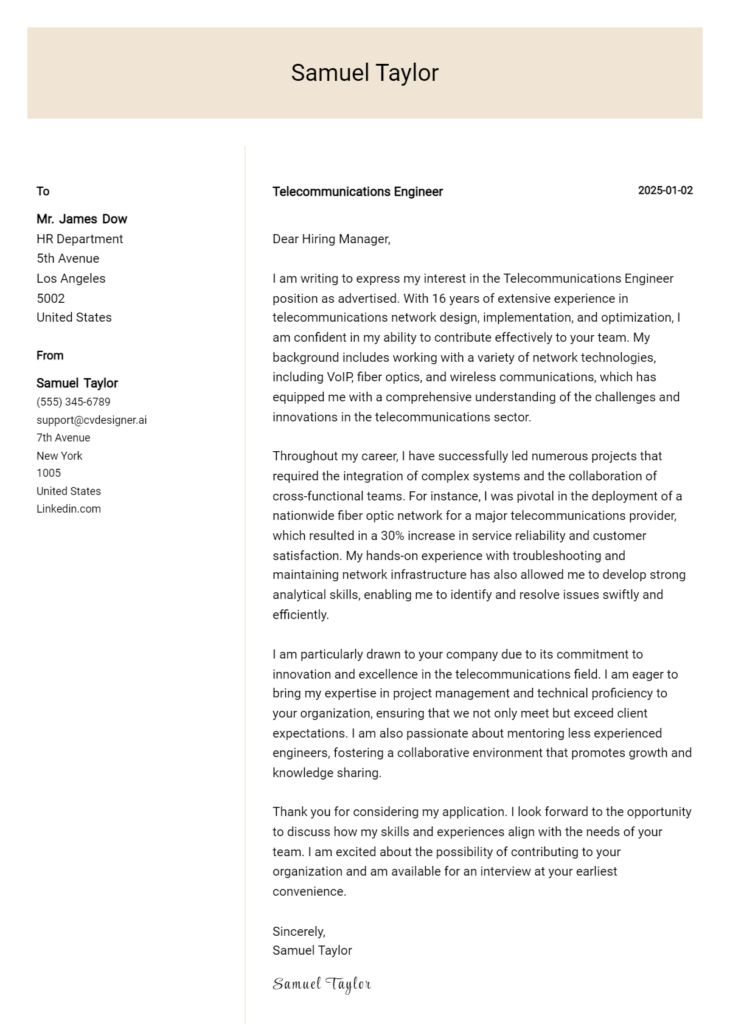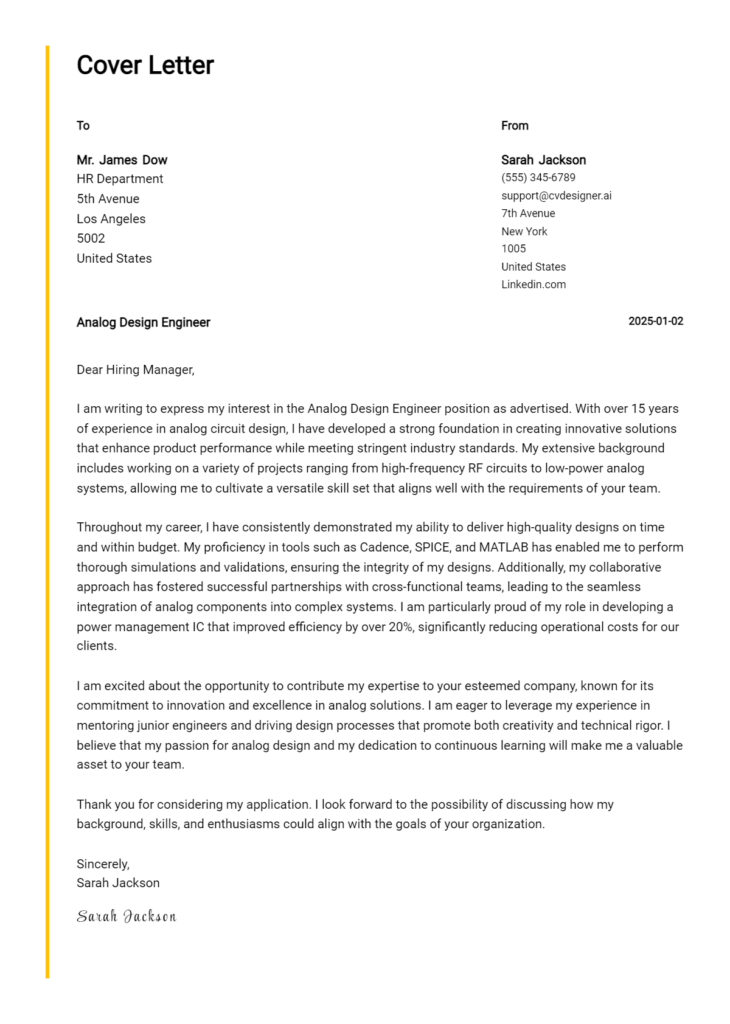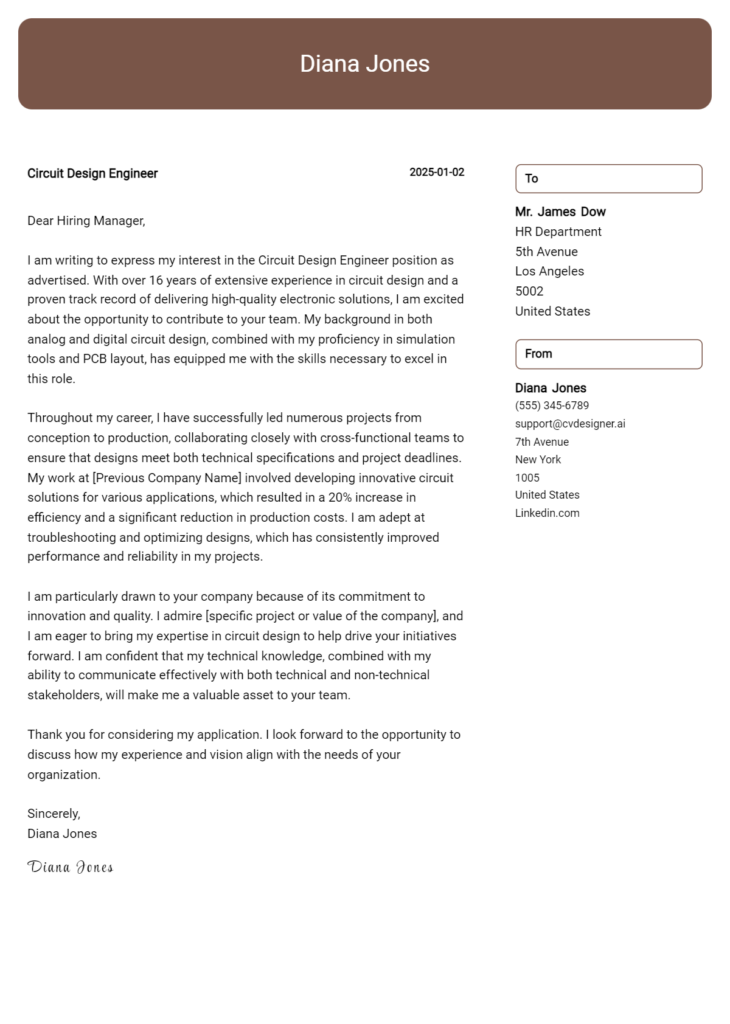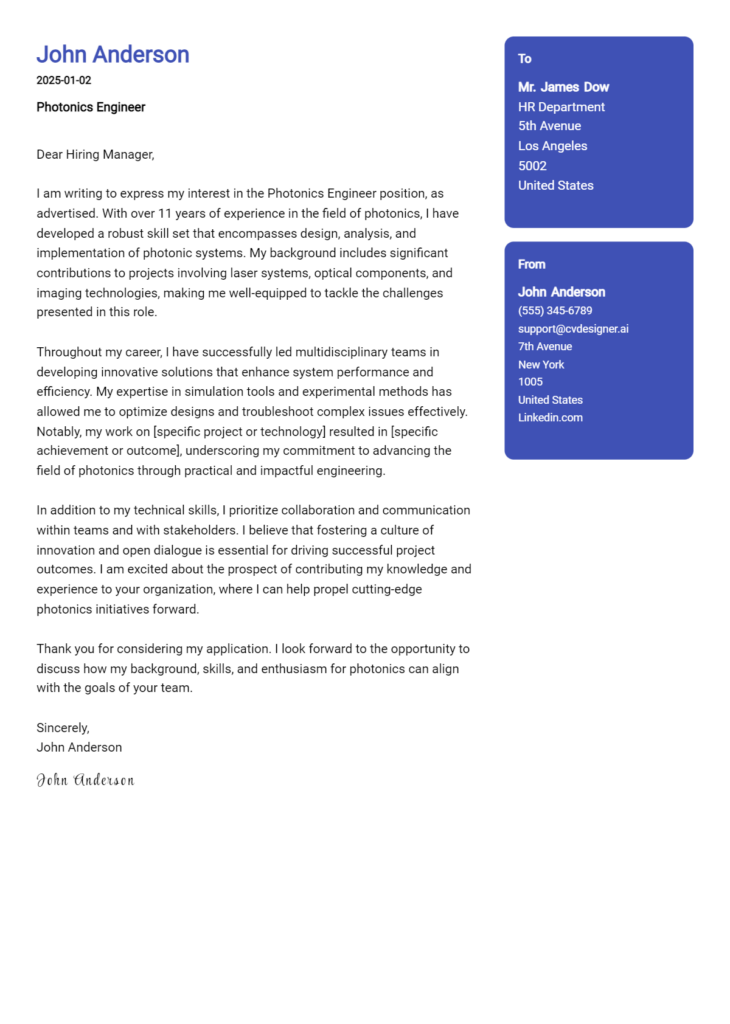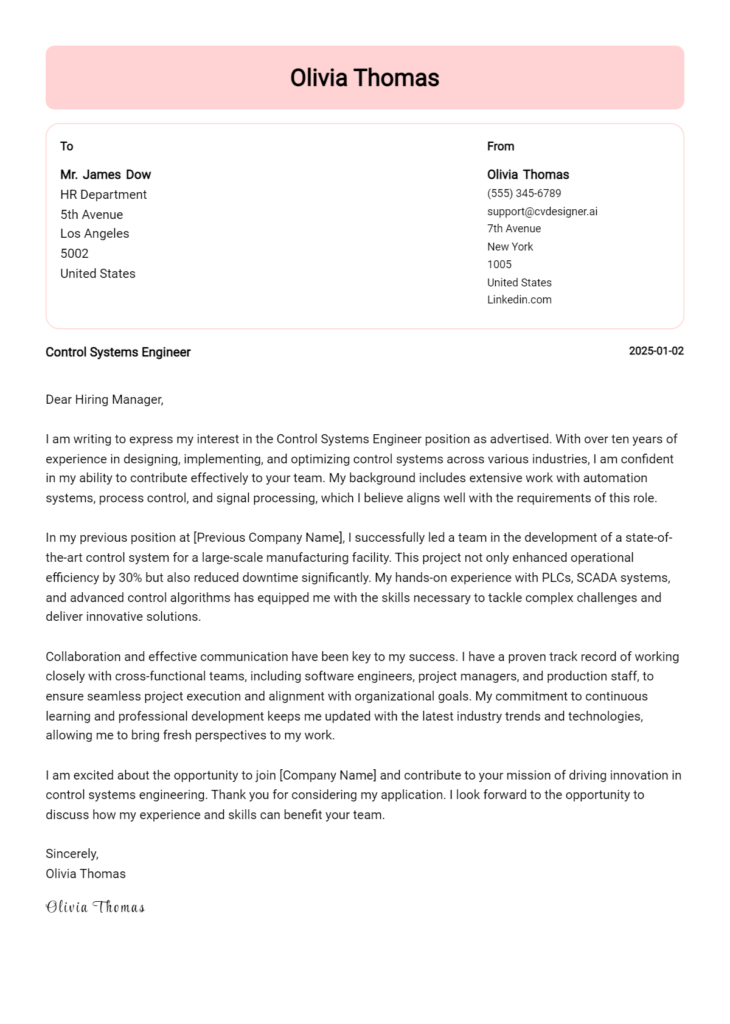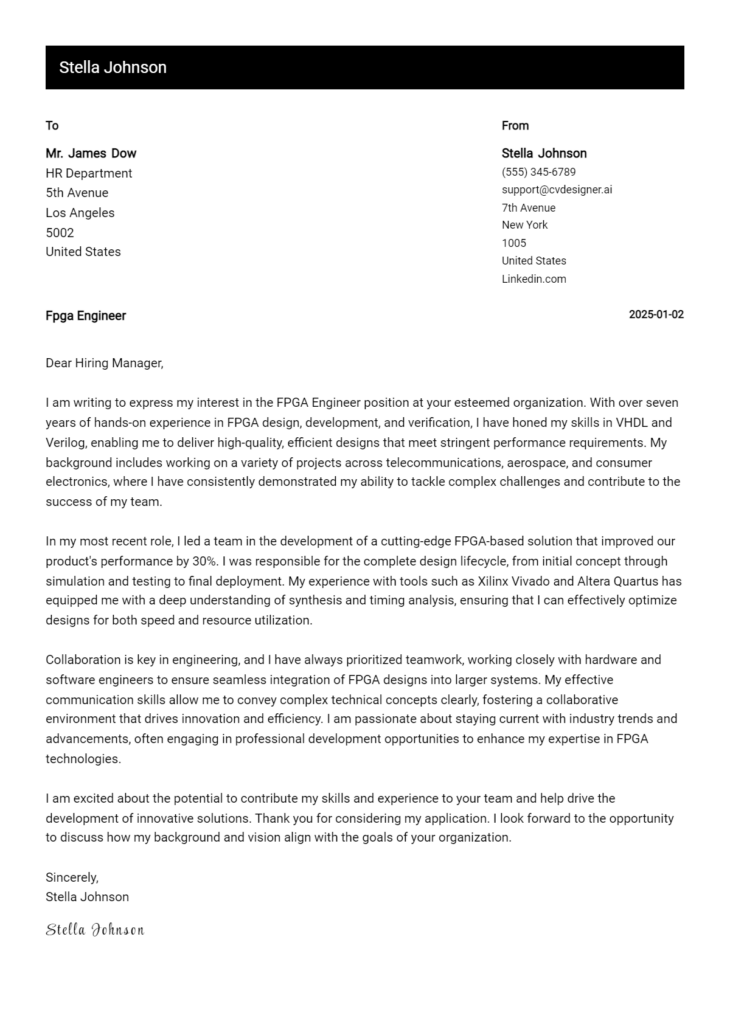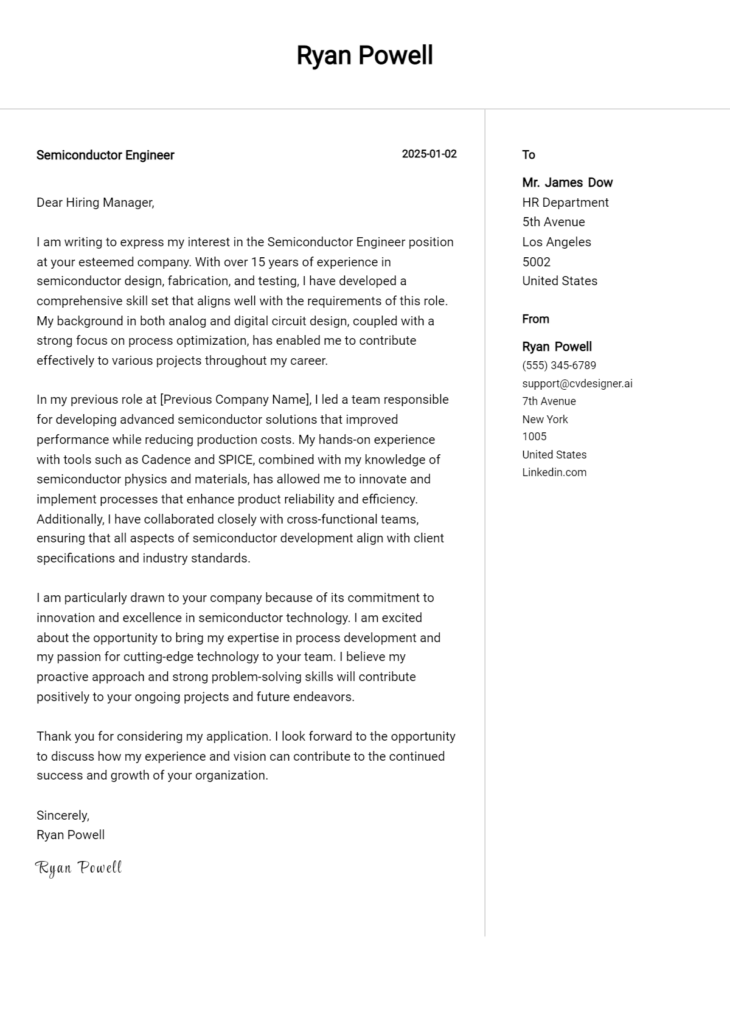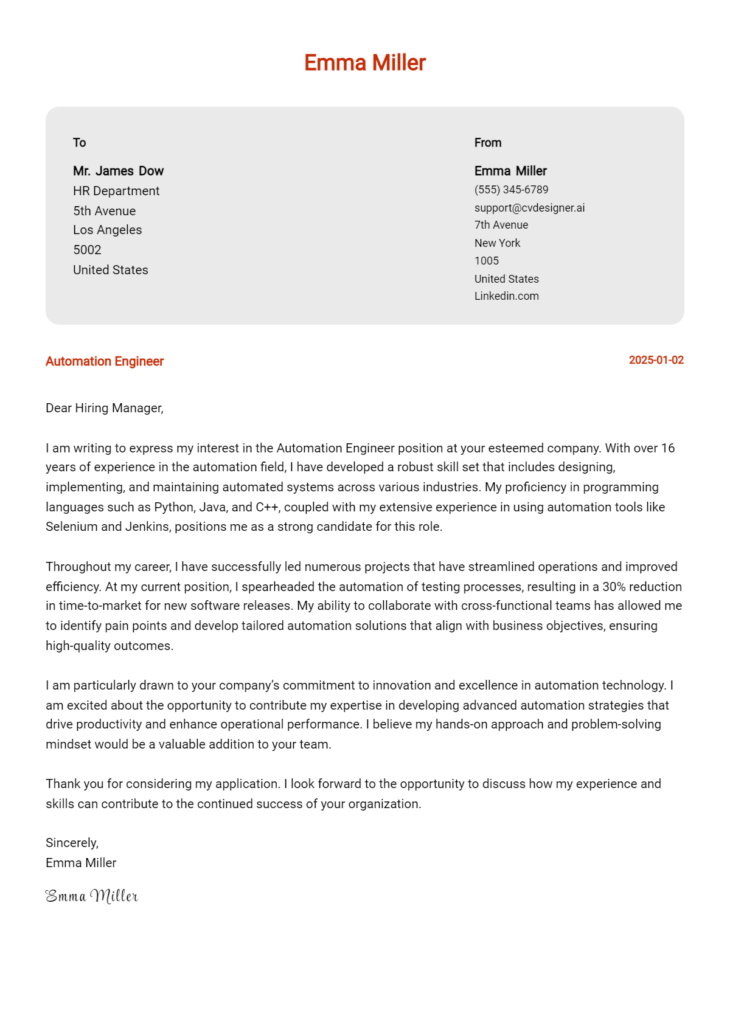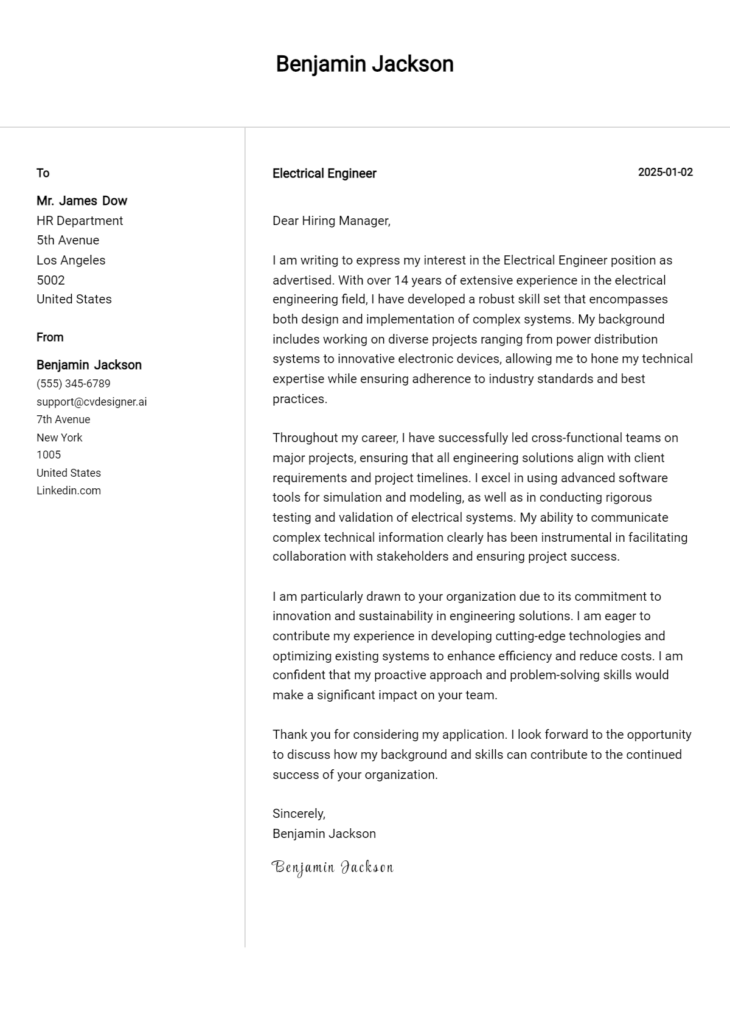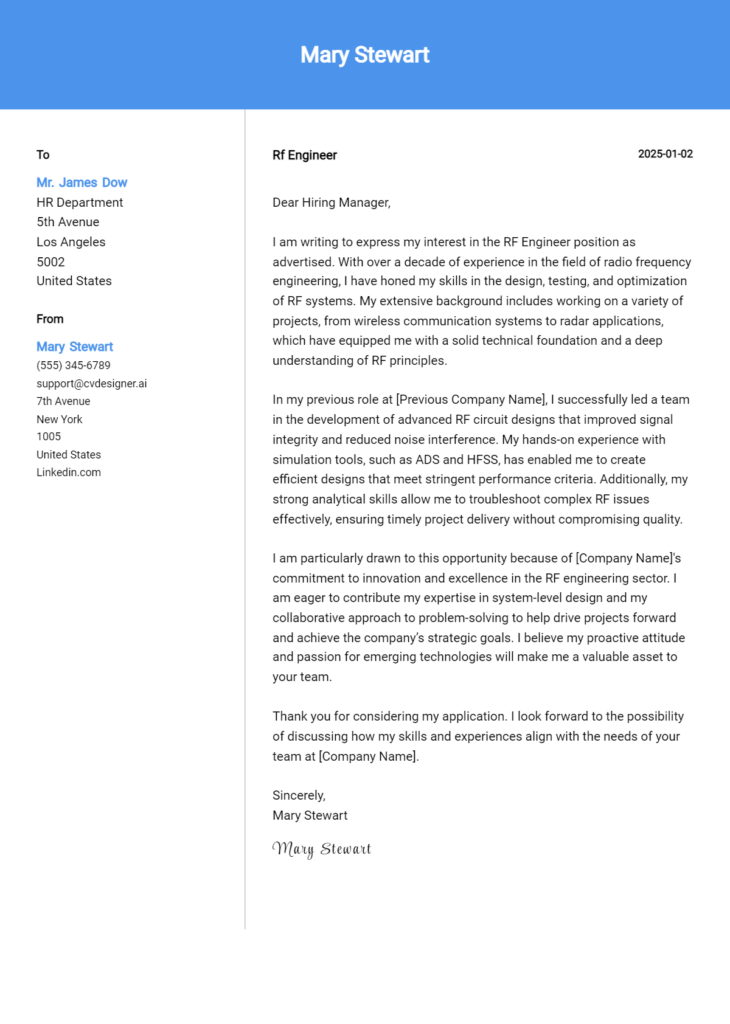Pcb Design Engineer Cover Letter Examples
Explore additional Pcb Design Engineer cover letter samples and guides and see what works for your level of experience or role.
How to Format a PCB Design Engineer Cover Letter?
Crafting a well-structured cover letter is essential for a PCB Design Engineer, as it not only showcases your technical abilities but also emphasizes your organizational skills and attention to detail. In the competitive field of electronics design, a well-formatted cover letter can make a significant difference in capturing the attention of hiring managers. It serves as your first opportunity to present yourself as a qualified candidate who understands the nuances of PCB design, from schematic capture to layout considerations.
In this guide, we will outline the key components of a professional cover letter, providing a clear roadmap to help you present your qualifications effectively.
We will focus on the essential sections of a cover letter, including:
- Cover Letter Header
- Cover Letter Greeting
- Cover Letter Introduction
- Cover Letter Body
- Cover Letter Closing
Each section is crucial in reflecting your professionalism and suitability for the role. Let’s delve into each part to ensure your PCB Design Engineer cover letter stands out in the hiring process.
Importance of the Cover Letter Header for a PCB Design Engineer
A well-crafted cover letter header is crucial for a PCB Design Engineer as it sets the tone for the application and conveys professionalism. The header should clearly present essential contact information, including your name, phone number, email address, and the date. Additionally, it should specify the recipient’s details, such as their name, title, and company address. Clarity in the header not only aids in easy identification but also demonstrates attention to detail, a vital trait in PCB design work. A polished header can make a strong first impression, reflecting your organizational skills and professionalism.
Strong Example
John Doe 1234 Elm Street Springfield, IL 62701 (555) 123-4567 john.doe@email.com October 5, 2023 Jane Smith Hiring Manager Tech Innovations Inc. 5678 Maple Avenue Springfield, IL 62701
Weak Example
John D. (555) 123-4567 johndoe@email.com 10/5/23 Tech Innovations 5678 Maple Ave
The Importance of a Cover Letter Greeting for PCB Design Engineer
A well-crafted cover letter greeting is crucial in establishing the tone for the rest of your letter. It not only reflects your professionalism but also adds a personal touch by addressing the hiring manager directly. A personalized greeting demonstrates your genuine interest in the position and the company, suggesting that you have taken the time to research and understand who you are reaching out to. To avoid sounding generic, it's essential to refrain from using phrases like "To Whom It May Concern." Instead, make an effort to find the recipient's name, which can often be located on the company website or LinkedIn. This small detail can significantly impact the impression you make.
Strong Greeting Example
Dear Ms. Johnson,
Weak Greeting Example
To Whom It May Concern,
The Importance of a Compelling Cover Letter Introduction for a PCB Design Engineer
A well-crafted cover letter introduction is crucial for a PCB Design Engineer, as it serves as the first impression a candidate makes on the hiring manager. This opening paragraph should immediately capture attention, express genuine interest in the role, and succinctly highlight key skills or achievements that set the candidate apart from others. A strong introduction not only draws the reader in but also establishes a foundation for the rest of the cover letter, paving the way for a compelling narrative about the candidate's qualifications and fit for the position.
Strong Example
Dear [Hiring Manager's Name], I am excited to apply for the PCB Design Engineer position at [Company Name], where my extensive experience in designing high-frequency circuit boards and my passion for innovative electronics can contribute significantly to your team. With a proven track record of reducing production costs by 20% through optimized designs and a commitment to exceeding project deadlines, I am eager to bring my technical skills and creative problem-solving abilities to [Company Name].
Weak Example
Dear [Hiring Manager's Name], I want to apply for the job of PCB Design Engineer because I think it's a good opportunity. I have some experience in PCB design and believe I can do the job well if given a chance.
Purpose of the Cover Letter Body for a PCB Design Engineer
The body of a cover letter for a PCB Design Engineer serves as a critical platform for candidates to articulate their technical skills, relevant experiences, and the unique value they can bring to a potential employer. It provides an opportunity to highlight specific projects or accomplishments that demonstrate proficiency in PCB design software, understanding of manufacturing processes, and successful collaboration with cross-functional teams. By detailing relevant experiences, candidates can effectively show how their background aligns with the company's needs and how they can contribute to its success.
Strong Example
Dear Hiring Manager, I am excited to apply for the PCB Design Engineer position at XYZ Technologies. In my previous role at ABC Electronics, I successfully led a project to design a multi-layer PCB for a high-frequency RF application. This project not only met all performance specifications but also reduced manufacturing costs by 15% through optimized layout and component selection. Additionally, my experience with Altium Designer and my strong understanding of DFM principles have equipped me to create designs that are both efficient and manufacturable. I am confident that my proactive approach and technical expertise will contribute significantly to your team. Sincerely, [Your Name]
Weak Example
Dear Hiring Manager, I am interested in the PCB Design Engineer position. I have worked on some PCB designs in the past and I know how to use some software tools. I think I could be a good fit for your company. I hope to learn more about your projects and contribute in any way I can. Best, [Your Name]
Importance of the Cover Letter Closing for a PCB Design Engineer
The closing paragraph of a cover letter is crucial as it encapsulates your qualifications, reiterates your enthusiasm for the PCB Design Engineer role, and prompts the hiring manager to take the next steps, such as reviewing your resume or scheduling an interview. A strong closing will leave a lasting impression, while a weak one can diminish the impact of your entire application.
Strong Example
Thank you for considering my application for the PCB Design Engineer position at [Company Name]. With my extensive experience in PCB design, proficiency in industry-standard tools, and a passion for innovative electronics, I am excited about the opportunity to contribute to your team. I believe my skills align well with the needs of your projects, and I would love to discuss how I can add value to your organization. Please feel free to review my resume for further details, and I look forward to the possibility of scheduling an interview to explore this opportunity together.
Weak Example
I hope you look at my resume. I want to work at [Company Name] because I think it would be nice. Let me know if you want to talk.
Writing an effective cover letter is crucial for PCB Design Engineer candidates to stand out in a competitive job market. This document serves as an opportunity to showcase not only your technical skills but also your problem-solving abilities, understanding of the software development life cycle (SDLC), teamwork capabilities, and a passion for continuous learning. By emphasizing these qualities, you can present yourself as a well-rounded candidate who is prepared to contribute to your prospective employer's success.
Cover Letter Writing Tips for PCB Design Engineer
Highlight Your Technical Skills: Begin your cover letter by outlining your key technical skills relevant to PCB design, such as proficiency in design software like Altium Designer or Eagle. Be specific about your experience and mention any specialized techniques, such as high-frequency design or mixed-signal design, to demonstrate your expertise.
Showcase Problem-Solving Abilities: Employers value engineers who can tackle challenges effectively. Share examples from your past projects where you identified a problem and implemented a successful solution. This could include design optimization, troubleshooting manufacturing issues, or improving circuit performance.
Demonstrate SDLC Knowledge: Understanding the software development life cycle is critical in PCB design projects. Discuss your experience with various stages of the SDLC, from requirement gathering and design to testing and deployment. This shows that you are not only a designer but also a strategic thinker who can contribute to project success.
Emphasize Teamwork and Collaboration: PCB design often involves working with cross-functional teams. Highlight your experience collaborating with software engineers, mechanical engineers, and project managers. Provide specific examples of how your contributions facilitated successful project outcomes and improved team dynamics.
Express a Passion for Continuous Learning: The field of PCB design is constantly evolving with new technologies and methodologies. Convey your enthusiasm for staying updated on industry trends by mentioning any additional training, certifications, or workshops you have pursued. This demonstrates your commitment to professional development and innovation.
By following these tips, you can create a compelling cover letter that effectively showcases your qualifications as a PCB Design Engineer. For additional guidance, consider using cover letter templates or try a cover letter builder to streamline the writing process and ensure your cover letter stands out.
Common Mistakes to Avoid in a PCB Design Engineer Cover Letter
Crafting a compelling cover letter is essential for a PCB Design Engineer role, as it serves as your first impression to potential employers. Avoiding common mistakes can significantly increase your chances of landing an interview. Here are some pitfalls to watch out for:
Generic Content: Tailoring your cover letter to the specific job is crucial. Avoid using a one-size-fits-all approach. Research the company and mention relevant projects or values.
Neglecting Formatting: A poorly formatted cover letter can detract from your qualifications. Follow a clear cover letter format that includes proper spacing, font, and alignment.
Excessive Length: Keep your cover letter concise—ideally one page. Avoid overwhelming the reader with unnecessary details. Focus on your most relevant experiences and skills.
Repetition of Resume: Your cover letter should complement your resume, not repeat it. Highlight specific achievements and explain how they relate to the PCB Design Engineer position.
Lack of Enthusiasm: A cover letter should convey your passion for the role. Avoid a monotonous tone; instead, express genuine interest in the company and the projects they undertake.
Ignoring Proofreading: Spelling and grammatical errors can undermine your professionalism. Always proofread your cover letter multiple times or ask someone else to review it before submission.
Failure to Include a Call to Action: Conclude your cover letter with a strong call to action, expressing your eagerness for an interview. This shows initiative and interest in the position.
By steering clear of these common mistakes, you can create a standout cover letter that highlights your qualifications as a PCB Design Engineer. For additional inspiration, check out various cover letter examples to help you craft your message effectively.
Cover Letter FAQs for PCB Design Engineer
What should be the main focus of my cover letter as a PCB Design Engineer?
As a PCB Design Engineer, your cover letter should primarily focus on showcasing your technical skills and relevant experience in PCB design. Highlight specific software proficiency, such as Altium Designer, Eagle, or KiCAD, and mention any industry-standard design practices you follow, such as IPC standards. Additionally, illustrate your problem-solving abilities through examples of past projects where you overcame design challenges or optimized layouts for performance and manufacturability. Finally, emphasize your ability to work in cross-functional teams and your understanding of the product lifecycle, as collaboration is key in this role.
How can I demonstrate my technical skills in my cover letter?
To effectively demonstrate your technical skills in your cover letter, provide concrete examples from your previous work experience. Mention specific projects where you applied your PCB design skills, including the types of circuits you designed (analog, digital, RF, etc.) and the complexities involved. Include metrics or outcomes that highlight your contributions, such as reduced production costs, improved signal integrity, or successful product launches. Additionally, you can reference certifications or training that are relevant to PCB design, such as courses in advanced PCB layout or simulation software, to further solidify your expertise.
Should I customize my cover letter for each job application?
Yes, customizing your cover letter for each job application is crucial. Tailoring your cover letter allows you to align your skills and experiences with the specific requirements and culture of the company you are applying to. Research the company’s projects, values, and recent developments in PCB technology they are involved in, and mention how your background and interests align with their work. This not only demonstrates your genuine interest in the role but also shows that you have taken the time to understand the company’s needs, making your application stand out.
What is the best way to conclude my cover letter for a PCB Design Engineer position?
In concluding your cover letter, express enthusiasm for the opportunity to contribute to the company and its projects. Reiterate your eagerness to bring your PCB design expertise to the team and how you can add value to their operations. Mention your desire for an interview to discuss your qualifications further and express appreciation for their consideration. A strong closing can include a call to action, such as, “I look forward to the possibility of discussing how my skills can meet your team's needs.” This leaves a positive impression and encourages further communication.
Build your Cover Letter in minutes
Use an AI-powered cover letter builder and have your letter done in 5 minutes. Just select your template and our software will guide you through the process.


